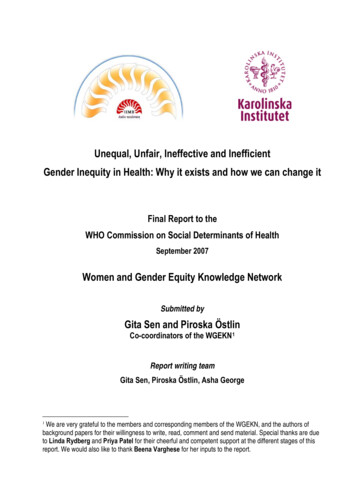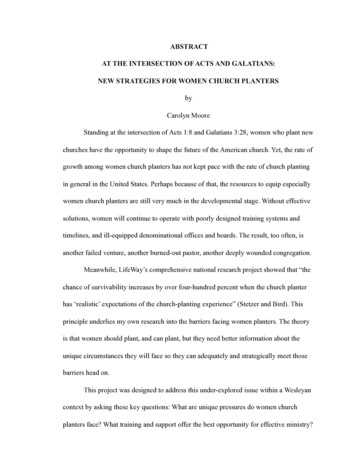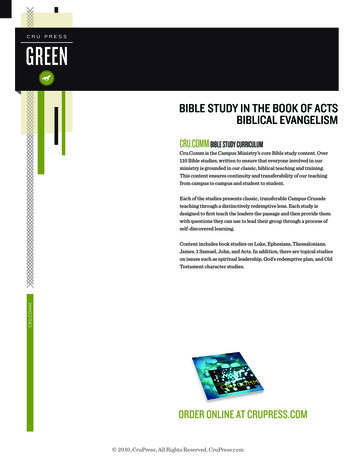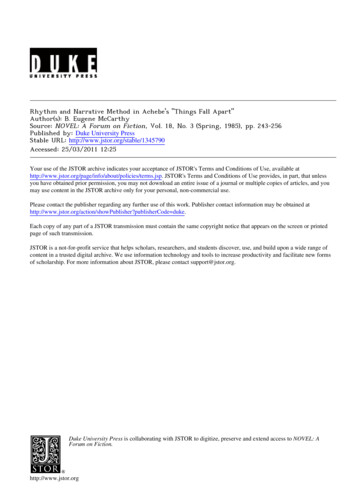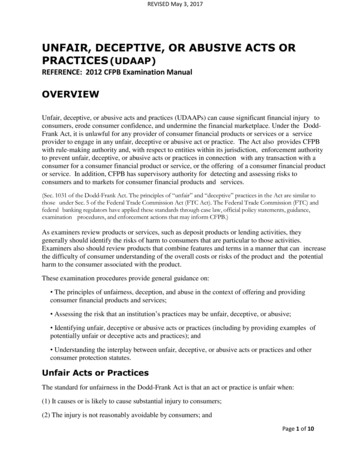
Transcription
REVISED May 3, 2017UNFAIR, DECEPTIVE, OR ABUSIVE ACTS ORPRACTICES (UDAAP)REFERENCE: 2012 CFPB Examination ManualOVERVIEWUnfair, deceptive, or abusive acts and practices (UDAAPs) can cause significant financial injury toconsumers, erode consumer confidence, and undermine the financial marketplace. Under the DoddFrank Act, it is unlawful for any provider of consumer financial products or services or a serviceprovider to engage in any unfair, deceptive or abusive act or practice. The Act also provides CFPBwith rule-making authority and, with respect to entities within its jurisdiction, enforcement authorityto prevent unfair, deceptive, or abusive acts or practices in connection with any transaction with aconsumer for a consumer financial product or service, or the offering of a consumer financial productor service. In addition, CFPB has supervisory authority for detecting and assessing risks toconsumers and to markets for consumer financial products and services.(Sec. 1031 of the Dodd-Frank Act. The principles of “unfair” and “deceptive” practices in the Act are similar tothose under Sec. 5 of the Federal Trade Commission Act (FTC Act). The Federal Trade Commission (FTC) andfederal banking regulators have applied these standards through case law, official policy statements, guidance,examination procedures, and enforcement actions that may inform CFPB.)As examiners review products or services, such as deposit products or lending activities, theygenerally should identify the risks of harm to consumers that are particular to those activities.Examiners also should review products that combine features and terms in a manner that can increasethe difficulty of consumer understanding of the overall costs or risks of the product and the potentialharm to the consumer associated with the product.These examination procedures provide general guidance on: The principles of unfairness, deception, and abuse in the context of offering and providingconsumer financial products and services; Assessing the risk that an institution’s practices may be unfair, deceptive, or abusive; Identifying unfair, deceptive or abusive acts or practices (including by providing examples ofpotentially unfair or deceptive acts and practices); and Understanding the interplay between unfair, deceptive, or abusive acts or practices and otherconsumer protection statutes.Unfair Acts or PracticesThe standard for unfairness in the Dodd-Frank Act is that an act or practice is unfair when:(1) It causes or is likely to cause substantial injury to consumers;(2) The injury is not reasonably avoidable by consumers; andPage 1 of 10
REVISED May 3, 2017(3) The injury is not outweighed by countervailing benefits to consumers or to competition.(The standard for unfairness in the Dodd-Frank Act has the same three-part test as the FTC Act. Thisstandard was first stated in the FTC Policy Statement on Unfairness (Dec. 17, 1980). ftc-policy-statement-unfairness. Congress later amendedthe FTC Act to include this specific standard in the Act itself. 15 U.S.C. § 45(n).) The act or practice must cause or be likely to cause substantial injury to consumers.Substantial injury usually involves monetary harm. Monetary harm includes, for example,costs or fees paid by consumers as a result of an unfair practice. An act or practice that causesa small amount of harm to a large number of people may be deemed to cause substantialinjury.Actual injury is not required in every case. A significant risk of concrete harm is alsosufficient. However, trivial or merely speculative harms are typically insufficient for a findingof substantial injury. Emotional impact and other more subjective types of harm also will notordinarily amount to substantial injury. Nevertheless, in certain circumstances, such asunreasonable debt collection harassment, emotional impacts may amount to or contribute tosubstantial injury. Consumers must not be reasonably able to avoid the injury.An act or practice is not considered unfair if consumers may reasonably avoid injury.Consumers cannot reasonably avoid injury if the act or practice interferes with their ability toeffectively make decisions or to take action to avoid injury. Normally the marketplace is selfcorrecting; it is governed by consumer choice and the ability of individual consumers to maketheir own private decisions without regulatory intervention. If material information about aproduct, such as pricing, is modified after, or withheld until after, the consumer hascommitted to purchasing the product; however, the consumer cannot reasonably avoid theinjury. Moreover, consumers cannot avoid injury if they are coerced into purchasingunwanted products or services or if a transaction occurs without their knowledge or consent.A key question is not whether a consumer could have made a better choice. Rather, thequestion is whether an act or practice hinders a consumer’s decision-making. For example,not having access to important information could prevent consumers from comparingavailable alternatives, choosing those that are most desirable to them, and avoiding those thatare inadequate or unsatisfactory. In addition, if almost all market participants engage in apractice, a consumer’s incentive to search elsewhere for better terms is reduced, and thepractice may not be reasonably avoidable. (See Credit Practices Rule, 49 Fed. Reg. 7740, 7746 (1984).)The actions that a consumer is expected to take to avoid injury must be reasonable. While aconsumer might avoid harm by hiring independent experts to test products in advance or bybringing legal claims for damages in every case of harm, these actions generally would be tooexpensive to be practical for individual consumers and, therefore, are not reasonable. The injury must not be outweighed by countervailing benefits to consumers orcompetition.To be unfair, the act or practice must be injurious in its net effects — that is, the injury mustnot be outweighed by any offsetting consumer or competitive benefits that also are producedPage 2 of 10
REVISED May 3, 2017by the act or practice. Offsetting consumer or competitive benefits of an act or practice mayinclude lower prices to the consumer or a wider availability of products and services resultingfrom competition.Costs that would be incurred for measures to prevent the injury also are taken into account indetermining whether an act or practice is unfair. These costs may include the costs to theinstitution in taking preventive measures and the costs to society as a whole of any increasedburden and similar matters.Public policy, as established by statute, regulation, judicial decision, or agency determination,may be considered with all other evidence to determine whether an act or practice is unfair.However, public policy considerations by themselves may not serve as the primary basis fordetermining that an act or practice is unfair.ExamplesThe examples described below stem from federal enforcement actions. They provide insight intopractices that have been alleged to be unfair by other regulators and may inform CFPB’sdeterminations. However, the particular facts in a case are crucial to a determination ofunfairness. It is important to bear in mind that a change in facts could change the appropriatedetermination. Moreover, the brief summaries below do not present all of the material factsrelevant to the determinations in each case. The examples show how the unfairness standard maybe applied.Refusing to release lien after consumer makes final payment on a mortgage.(FTC v. Capital City Mortgage Corp., Civil No. 98 CV-237 (D.D.C. Feb. 2005), available ration-et-alThe FTC brought an enforcement action against a mortgage company based on allegations,described below, that repeatedly failed to release liens after consumers fully paid the amount dueon their mortgages. Substantial injury. Consumer’s sustained economic injury when the mortgage servicer didnot release the liens on their properties after the consumers had repaid the total amount due onthe mortgages. Not outweighed by benefits. Countervailing benefits to competition or consumers did notresult from the servicer’s alleged failure to appropriately service the mortgage loan andrelease the lien promptly. Not reasonably avoidable. Consumers had no way to know in advance of obtaining the loanthat the mortgage servicer would not release the lien after full payment. Moreover, consumersgenerally cannot avoid the harm caused by an improper practice of a mortgage servicerbecause the servicer is chosen by the owner of the loan, not the borrower. Thus, consumerscannot choose their loan servicer and cannot change loan servicers when they are dissatisfiedwith the quality of the loan servicing.Page 3 of 10
REVISED May 3, 2017Dishonoring credit card convenience checks without notice.(In re American Express Bank, FSB (Cease and Desist Order WN-09-016, and Order of Assessment of a Civil MoneyPenalty for 250,000, WN-09-017, June 29, 2009) OTS Docket No. 15648; In re American Express Centurion Bank, (Ceaseand Desist Order, June 30, 2009) Docket FDIC-09-251b, available at http://www fdic.gov/news.)The OTS and FDIC brought enforcement actions against a credit card issuer that sentconvenience checks with stated credit limits and expiration dates to customers. For a significantpercentage of consumers, the issuer reduced credit lines after the checks were presented, andthen the issuer dishonored the consumers’ checks. Substantial injury. Customers paid returned-check fees and may have experienced a negativeimpact on credit history. Not outweighed by benefits. The card issuer later reduced credit limits based on creditreviews. Based on the particular facts involved in the case, the harm to consumers from thedishonored convenience checks outweighed any benefit of using new credit reviews. Not reasonably avoidable. Consumers reasonably relied on their existing credit limits andexpiration dates on the checks when deciding to use them for a payment. Consumers hadreceived no notice that the checks they used were being dishonored until they learned fromthe payees. Thus, consumers could not reasonably have avoided the injury.Processing payments for companies engaged in fraudulent activities.(In re Wachovia Bank, National Association, available at 08/nr-occ-2008-48.htmlThe OCC brought an enforcement action in a case involving a bank that maintained depositaccount relations with telemarketers and payment processors, based on the following allegations.The telemarketers regularly deposited large numbers of remotely created checks drawn againstconsumers’ accounts. A large percentage of the checks were not authorized by consumers. Thebank failed to establish appropriate policies and procedures to prevent, detect, or remedy suchactivities. Substantial injury. Consumers lost money from fraudulent checks created remotely anddrawn against their accounts. Not outweighed by benefits. The cost to the bank of establishing a minimum level of duediligence, monitoring, and response procedures sufficient to remedy the problem would havebeen far less than the amount of injury to consumers that resulted from the bank’s avoidingthose costs. Not reasonably avoidable. Consumers could not avoid the harm because the harm resultedprincipally from transactions to which the consumers had not consented.Page 4 of 10
REVISED May 3, 2017Deceptive Acts or PracticesA representation, omission, actor practice is deceptive when(1) The representation, omission, act, or practice misleads or is likely to mislead the consumer;(2) The consumer’s interpretation of the representation, omission, act, or practice is reasonableunder the circumstances; and(3) The misleading representation, omission, act, or practice is material.See FTC Policy Statement on Deception, available c statements/410531/831014deceptionstmt.pdf There must be a representation, omission, act, or practice that misleads or is likely to misleadthe consumer.Deception is not limited to situations in which a consumer has already been misled. Instead, anact or practice may be deceptive if it is likely to mislead consumers.It is necessary to evaluate an individual statement, representation, or omission not in isolation,but rather in the context of the entire advertisement, transaction, or course of dealing, todetermine whether the overall net impression is misleading or deceptive. A representation maybe an express or implied claim or promise, and it may be written or oral. If material informationis necessary to prevent a consumer from being misled, it may be deceptive to omit thatinformation.Written disclosures may be insufficient to correct a misleading statement or representation,particularly where the consumer is directed away from qualifying limitations in the text or iscounseled that reading the disclosures is unnecessary. Likewise, oral or fine print disclosures orcontract disclosures may be insufficient to cure a misleading headline or a prominent writtenrepresentation. Similarly, a deceptive act or practice may not be cured by subsequent truthfuldisclosures.Acts or practices that may be deceptive include: making misleading cost or price claims; offeringto provide a product or service that is not in fact available; using bait-and-switch techniques;omitting material limitations or conditions from an offer; or failing to provide the promisedservices.The FTC’s “four Ps” test can assist in the evaluation of whether a representation, omission, act,or practice is likely to mislead:o Is the statement prominent enough for the consumer to notice?o Is the information presented in an easy-to-understand format that does not contradict otherinformation in the package and at a time when the consumer’s attention is not distractedelsewhere?Page 5 of 10
REVISED May 3, 2017o Is the placement of the information in a location where consumers can be expected to look orhear?o Finally, is the information in close proximity to the claim it qualifies? The representation, omission, act, or practice must be considered from the perspective of thereasonable consumer.(FTC, Dot Com Disclosures, Information about On-Line Advertising, available at /2014/09/full-disclosureIn determining whether an act or practice is misleading, one also must consider whether theconsumer’s interpretation of or reaction to the representation, omission, act, or practice is reasonableunder the circumstances. In other words, whether an act or practice is deceptive depends on how areasonable member of the target audience would interpret the representation. When representationsor marketing practices target a specific audience, such as older Americans, young people, orfinancially distressed consumers, the communication must be reviewed from the point of view of areasonable member of that group.Moreover, a representation may be deceptive if the majority of consumers in the target class do notshare the consumer’s interpretation, so long as a significant minority of such consumers is misled.When a seller’s representation conveys more than one meaning to reasonable consumers, one ofwhich is false, the seller is liable for the misleading interpretation.Exaggerated claims or “puffery,” however, are not deceptive if the claims would not be takenseriously by a reasonable consumer. The representation, omission, or practice must be material.A representation, omission, act, or practice is material if it is likely to affect a consumer’s choice of,or conduct regarding, the product or service. Information that is important to consumers is material.Certain categories of information are presumed to be material.In general, information about the central characteristics of a product or service – such as costs,benefits, or restrictions on the use or availability – is presumed to be material. Express claims madewith respect to a financial product or service are presumed material. Implied claims are presumed tobe material when evidence shows that the institution intended to make the claim (even though intentto deceive is not necessary for deception to exist).Claims made with knowledge that they are false are presumed to be material. Omissions will bepresumed to be material when the financial institution knew or should have known that theconsumer needed the omitted information to evaluate the product or service.If a representation or claim is not presumed to be material, it still would be considered material ifthere is evidence that it is likely to be considered important by consumers.Page 6 of 10
REVISED May 3, 2017ExamplesThe examples described below stem from federal enforcement actions. They provide insight intopractices that have been alleged to be deceptive by other regulators and may inform CFPB’sdeterminations. However, as with unfairness, the particular facts in a case are crucial to adetermination of deception. It is important to bear in mind that a change in facts could change theappropriate determination. Moreover, the brief summaries below do not present all of thematerial facts relevant to the determinations in each case. The examples show how the deceptionstandard may be applied.Inadequate disclosure of material lease terms in television advertising.(In the matters of Mazda Motor of America, Inc.; Mitsubishi Motor Sales of America, Inc.; American Honda Motor Company,Inc.; General Motors Corporation; American Isuzu Motors, Inc., available at es-and-affirmativeThe FTC brought actions against vehicle leasing companies alleging that their televisionadvertisements represented that consumers could lease vehicles for “ 0 down” when advertisinga monthly lease payment. However, the FTC alleged that the “blur” of “unreadable fine print”that flashed on the screen at the end of the advertisement disclosed costs of at least 1,000. Thesettlements prohibited the vehicle leasing companies from misrepresenting the amountconsumers must pay when signing the lease.In addition, the FTC required that if the companies make any representation about the amountsdue at lease signing, or that there is “no down payment,” the companies must make an equallyprominent (readable and audible) disclosure of the total amount of all fees due when consumerssign the lease. Representation or omission likely to mislead. The television advertisements featuredprominent statements of “no money down” or “ 0 down” at lease signing. The advertisementalso contained, at the bottom of the screen, a “blur” of small print in which disclosures ofvarious costs required by Regulation M (the Consumer Leasing Act) were made. The FTCalleged that the disclosures were inadequate because they were not clear, prominent, oraudible to consumers. Reasonable consumer perspective. A reasonable consumer would believe that he did nothave to put any money down and that all he owed was the regular monthly payment. Material representation. The stated “no money down” or “ 0 down” plus the low monthlylease payment were material representations to consumers. The fact that the additional,material costs were disclosed at signing of the lease did not cure the deceptive failure todisclose in the television advertising, the FTC claimed.Misrepresentation about loan terms.(FTC v. Chase Financial Funding, Inc., No. SACV04-549 (C.D.Cal. 2004), Stipulated Preliminary Injunction,available s/cases/2004/06/040602stip0223287.pdfIn 2004, the FTC sued a mortgage broker advertising mortgage refinance loans at “3.5% fixedpayment 30-year loan” or “3.5% fixed payment for 30 years,” implying that the offe
unreasonable debt collection harassment, emotional impacts may amount to or contribute to substantial injury. Consumers must not be reasonably able to avoid the injury. An act or practice is not co
